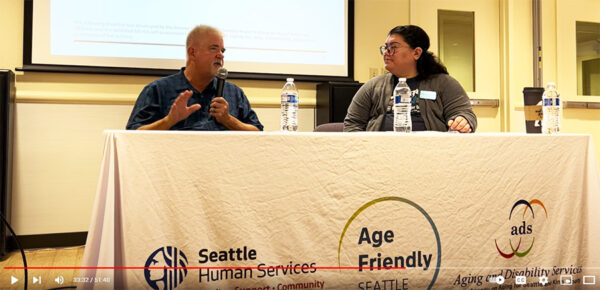Civic Coffee Recap: Falls Prevention and Home Safety

During Falls Prevention Week, Age Friendly Seattle hosted its monthly Civic Coffee on Sept. 26 in partnership with Kin ON in South Seattle. The panel discussion on Falls Prevention and Home Safety Modifications included Mae Amorin of Habitat for Humanity Seattle-King County and Dale Miller and Paige Denison of Sound Generations.
Why were we talking about preventing falls?
- One out of five falls by older adults causes a serious injury such as broken bones or a head injury.
- Three million older adults are treated in hospital emergency rooms for fall injuries each year.
- Every 11 seconds, an older adult is seen in an emergency room for a fall-related injury.
- Accidental falls accounted for 50 percent of all injury-related deaths of Washington state residents ages 65 and older in 2022.
After providing these alarming statistics, Denison described the two main types of falls. Same-level falls, such as tripping over an object on the floor, are the most common. Elevated falls occur from a height, like from a ladder or stairs.
There are three main risk factors that contribute to falls and typically a fall results from a combination of these factors. The first is physical; changes in the body that increase the likelihood of falling, such as weakened leg muscles due to inactivity or impaired vision that affects coordination. The second is behavioral; actions or decisions that can heighten the risk of falling. Lastly, environmental risk factors are hazards in and around the home, like a missing handrail or a broken step.
The National Council on Aging’s 6 Steps to Prevent a Fall are:
- Find a good balance and exercise program.
- Talk to your healthcare provider to assess your risk of falling.
- Regularly review your medications with your doctor or pharmacist.
- Get your vision and hearing checked annually and update your eyeglasses.
- Keep your home safe from trip hazards and improve lighting and accessibility.
- Talk to your family members to enlist their support in improving home safety.

Click on the image above to watch a video recording of the Civic Coffee on home safety (YouTube, 51:40
Amorin and Miller focused specifically on step 5: keeping your home safe by removing trip hazards, improving lighting, securing stairs, installing grab bars, and other similar precautions.
STAIRS — It’s essential to keep stairs clear of objects and well-lit with light switches at both the top and bottom of the stairs. Night lights are also an inexpensive and effective way to enhance lighting.
WALKWAYS — Similarly, keeping all floors uncluttered is crucial. Items like shoes, laundry, or pet toys are trip hazards. Throw rugs should be secured to the floor with double-sided tape or simply removed.
KITCHENS — These are common fall areas due to slipping on spills or tripping over mats. It’s best to keep frequently used items at waist level or lower, but if you need to use a stool to reach higher shelves, make sure it has a handrail and non-slip adhesives on the steps.
BEDROOMS — Reducing fall risks here can be as simple as keeping a lamp or flashlight within easy reach to provide clear lighting during the night. Motion-sensing night lights can also make nighttime bathroom or other trips safer.
BATHROOMS — Extra caution is required here because hard and wet surfaces in a small space pose a significant risk. Installing grab bars is essential. Use those that screw securely into the wall rather than with suction cups. Non-slip strips on the bathtub or shower floor are effective.
After explaining how to address these hazards, Amorin and Miller described the services their organizations provide to help folks maintain safer, more accessible homes.
Habitat for Humanity’s Home Repair Program provides discounted Critical Home Repairs for big issues like roof replacement, plumbing, and electrical work. Minor Home Repairs, such as gutter cleaning, debris removal, and accessibility upgrades like installing grab bars, are just $50. They even offer a CAPABLE program where participants work with an Occupational Therapist and a Registered Nurse to set goals for living more safely at home and to recommend accessibility upgrades and minor home repairs for free. To qualify, homeowners’ income must be at or below 80 percent of the county’s Area Median Income, have active homeowners’ insurance, and provide documentation of the needed repairs.
Sound Generation’s Minor Home Repair program offers services that include plumbing, toilet repairs, handrail and grab bar installations, and light fixture replacements. It is free to eligible participants who own their home, meet certain income requirements, and live within the service areas of Seattle, Bellevue, Shoreline, Black Diamond, Maple Valley, Enumclaw, Pacific, Algona, Normandy Park, and unincorporated south King County.
All are encouraged to apply for these programs, even if you think you may not qualify. Reach out to Habitat for Humanity or Sound Generations for assistance with any part of the application process.
 Contributor Reese Wohrle is an intern with Age Friendly Seattle. He is studying Community, Environment, and Planning at the University of Washington’s School of Built Environments.
Contributor Reese Wohrle is an intern with Age Friendly Seattle. He is studying Community, Environment, and Planning at the University of Washington’s School of Built Environments.
![AgeWise King County [logo]](https://www.agewisekingcounty.org/wp-content/themes/agewisekingcounty/images/logo.png)